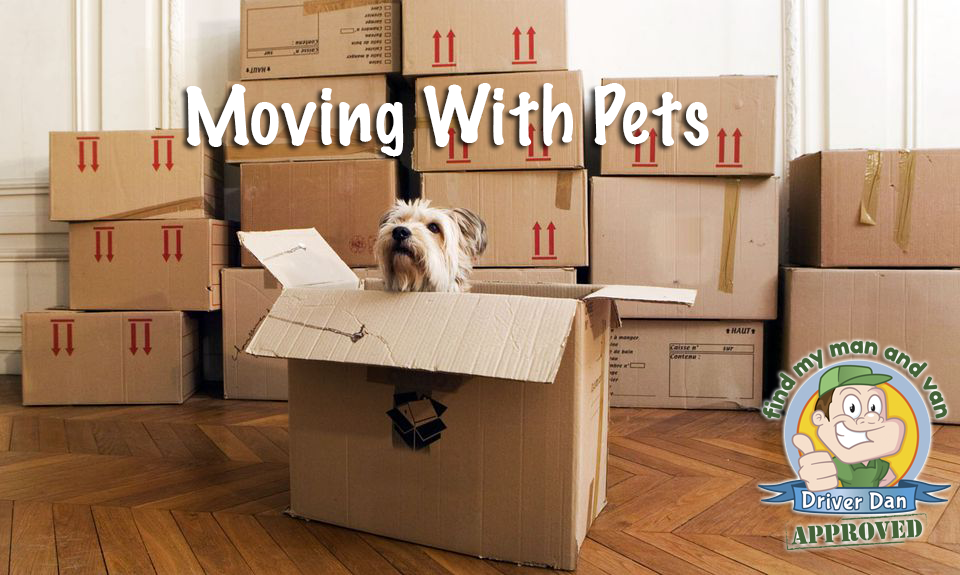Moving pets? Prepare, implement, and relax: 3 key steps to ensure your furry friends stay happy and stress-free during relocation. #PetMove
Moving House With Pets - Tips To Help Them Stay Happy
Very few people remain in the same home for life any longer, and those of us that have pets understand that the change is as much an upheaval for them as it is for us, if not more. It's easy to book your man and van hire with Find My Man and Van and with this guide it should be easy to make sure your pets have a safe and stress free move as well.
Make Moving Home Easier With Your Pets in 3 Steps
Whether you're hiring a man with a van or a removal company, it is important to tell the person or business that you've contracted that you have pets. Moving cats and dogs and all the preparation and moving is usually the remit of the pet owner. However, if you have to move aquarium equipment for tropical fish or reptiles, when your movers know about this, they will prepare to have the aquariums be amongst the last things put on the vehicle so that they may be the first items to come off.
In fact, if there is anything that belongs to your pets that cannot travel with you in the car, this is a good consideration, be it dog beds, play equipment or anything familiar to your pet. When you move, you want to put your pets at ease or in their normal home as quickly as possible.
Preparation, implementation and habitation will be the order of the day
Preparation will start anything up to a week in advance.
Implementation will take place on your moving-day.
Habitation after your move is about getting your pet used to their new home.
Preparation
Pet owners worldwide will tell you that their beloved animal friends know when something is up. You pack a case to go on a business trip, and they're climbing into it to obstruct your progress because they know you're planning to leave. They are likely to experience even more distress when you start to pack a week or two ahead of time.
For dogs, cats, and other mammals such as rats, hamsters, and rabbits, make sure that their diets do not suddenly change. Keep as much the same as you can: the same food, the same time, and the same routine.
If you must pack their beds or cages, then keep their favourite blanket and some of their most used toys out so they are not completely disassociated from what is happening around them.
With reptiles and fish, you will only remove them from their aquaria the day of the move but try to keep the room they are in as low-impact as possible. An increase in light use late at night due to packing can distress exotic animals, too.
Pay attention to them. Even though you are likely to be very busy over the days before the move and on the move day itself, make sure you reassure your dogs by walking them and petting them. Make sure to keep feeding times in the days leading up to the move the same. Cats, however aloof they may appear to be, also suffer stress when there are changes in the home environment. Keep their routine point perfect and provide plenty of opportunities for affection.
Fish, especially tropical fish need to be transferred to polybags containing aquarium water and placed in a polystyrene container. The polybags will provide all the nutrients that they need, and the water will be sufficiently oxygenated for around twelve hours. The polystyrene boxes provide a calm environment for transport. Keep about 50% of the original aquarium water for the new set up in the new home.
Implementation
Since cats are wandering animals, it may be necessary to confine them indoors the day before the move. If your cat disappears for hours at a time, it may be wise to confine them for at least twenty-four hours before the move. You should only place them in the cat box as close to the actual transfer to the car or van as you can.
Once the movers arrive, dogs will need to be confined. Placing them in their crate with their usual bedding and a few familiar toys will make an enormous difference. Putting them in the quietest possible place or emptiest room and often even covering the crate to make it darker will calm them, too.
Remember to let the dog out to go to the toilet, especially if the man-with-van process takes several hours. If the journey is long, remember to stop to let the dog out for a drink and a toilet break, always keeping them on the end of a short lead.
Make sure your animals are tagged or chipped. Cats and dogs tend to find their way back to their old homes, especially if they are in the same neighbourhood and they discover common routes and scent trails.
Because exotic animals have complex needs, preparation and implementation usually take place in the same twelve-hour period for aquarium animals. The closer to actual moving they are removed from their habitat, the better for them. This is particularly critical if they need temperature maintenance.
Habitation
Once you have arrived at your new home and the removal company has departed, successfully moving your animal is not over.
Keep cats confined to the new house so they may leave their scent and take ownership of it. When you see your cats rubbing themselves against walls, doorways, furniture, and other household objects, this will tell you that they're making the place theirs.
Dogs want to explore their new environments inside and out. To ensure that they understand that this is their new territory, provide plenty of smaller meals and spend time with them in the garden. Keep your dog confined for the first few days, and when taking a walk, always keep on a lead, even in a new park.
By bringing along the familiar, they will settle in quickly and associate the change with their old beds, blankets, and toys as something positive.
With aquaria, use 50% of the water that you brought along. This will reduce the shock to the fish and establish quick regrowth of healthy bacteria in the aquarium. Try to position the aquarium in a room with lighting similar to the furniture's placement.
With exotic pets, remember that room temperatures differ, and check the heating lamps so that they don't suffer hypothermia or overheat in the new home.
It may also be a good idea to establish which of your new neighbours have pets. If you have a dog that simply can't stand cats and the old lady next door has ten rescue cats, there could be some contingencies that need to be put in place before the move takes place. Pets are great for breaking the ice with new people but remember their behaviour can also sour neighbour relationships.





